
Ontario's northern forest, growing around a rock in Killarney Provincial Park: clockwise from top are Abies balsamea, Tsuga canadensis, Thuja occidentalis, Pinus resinosa, Pinus strobus, and Picea mariana.

Foliage with old pollen cones; and a winged seed. Coin is 24.26 mm diameter; Door Peninsula, Wisconsin [C.J. Earle, 2019.10.07].

Branch showing old cones (previous year), current year ripe cones, foliage, 1- to 4-year-old twigs, and 4-year-old cladoptosic twigs soon to fall; Keweenaw Peninsula, Michigan [C.J. Earle, 2019.10.02].
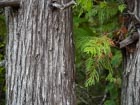
Bark on a tree about 30 cm diameter; Keweenaw Peninsula, Michigan [C.J. Earle, 2010.10.02].
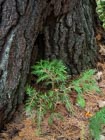
Seedling regenerating at the base of a large Pinus strobus; Keweenaw Peninsula, Michigan [C.J. Earle, 2019.10.02].

Twined roots of Thuja occidentalis and Betula alleghaniensis; upper Michigan [C.J. Earle, 2019.10.03].
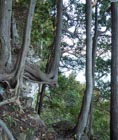
Trees dangling off the brink of the Niagara Escarpment, Door Peninsula, Wisconsin [C.J. Earle, 2019.10.07].

View from the brink of the Niagara Escarpment, showing how the cliff is completely covered in a pure stand of Thuja occidentalis; Door Peninsula, Wisconsin [C.J. Earle, 2019.10.07].
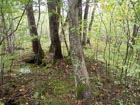
Swamp forest dominated by Thuja occidentalis; Chequamegon-Nicolet National Forest, Wisconsin [C.J. Earle, 2019.10.01].
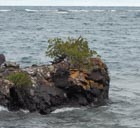
Small tree clinging to the rocky shoreline of Lake Superior; Keweenaw Peninsula, Michigan [C.J. Earle, 2019.10.02].
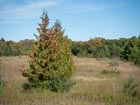
Former agricultural field on the Door Peninsula of Wisconsin being invaded by Thuja occidentalis, Pinus sylvestris (naturalized in this region), and Juniperus communis [C.J. Earle, 2019.10.07].

Conservation Status

Thuja occidentalis
Linnaeus 1753, p. 1002
Common names
Northern white-cedar, eastern whitecedar, arborvitae; thuier cèdre, cèdre-thuya occidental [French]; giizhik [Ojibwe]; ニオイヒバ [Japanese].
Taxonomic notes
Description
Monoecious trees to 25 m tall and 100 cm dbh, usually with a single straight stem and a conical crown, but can reproduce by layering and this may yield multiple stems. Bark red-brown, turning gray with age, 6-9 mm thick, fibrous, fissured, coming away in long, thin strips. Branchlets flattened, bearing foliage in flattened, fan-shaped sprays. Leaves scale-like, 1-4 mm long and 1-2 mm wide, pointed, dull yellow-green on both top and bottom, with conspicuous glands on lateral leaves near branchlet tips. Pollen cones 1-2 mm long, reddish. Seed cones ovoid, 9-14 mm long, green maturing to brown, with two pairs of woody fertile scales yielding a total of 8 seeds. Seeds red-brown, 4-7 mm long (including wings). 2n = 22" (Chambers 1993 and pers. obs.). See García Esteban et al. (2004) for a detailed characterization of the wood anatomy.
Distribution and Ecology
Canada: Manitoba, Ontario, Québec; Prince Edward Island, New Brunswick, Nova Scotia; USA: Minnesota, Michigan, Wisconsin, Illinois, Indiana, Ohio, Kentucky, Tennessee, North Carolina, Virginia, West Virginia, Maryland, Pennsylvania, New York, Connecticut, Massachusetts, Vermont, New Hampshire, Maine; at 0-900 m elevation on mostly calcareous substrates, neutral to basic swamps, shores of lakes and rivers, uplands, cliffs, and talus. Isolated stands occur north and east of its general range in Canada (to 51° 31' N latitude in Ontario, 50° N in Quebec). In the United States south of the Great Lakes and in southern New England, it occurs locally in scattered stands and is rare or extirpated at numerous former sites. In some areas, heavy winter browsing by deer greatly reduces reproductive success through elimination of seedlings or saplings (Chambers 1993). See also Thompson et al. (1999). Hardy to Zone 2 (cold hardiness limit between -45.6°C and -40.0°C) (Bannister and Neuner 2001).
Distribution data from USGS (1999). Points plotted as tree icons represent isolated or approximate locations.
Remarkable Specimens
The largest known has a dbh of 175 cm, height 34 m, crown spread 13 m, located in Leelanau County, MI (American Forests 1996). The tallest known specimen is in Clifton Gorge Nature Preserve, Ohio, and was 27.9 m tall when discovered in 2013 (Markworth 2013).
"The oldest living cedar that we have lives on a cliff face and it germinated in 952 A.D. (i.e. 1051 years old). This was determined from a cross-dated tree-ring count back to 1039 A.D. plus an estimated 87 years lost from the pith area. The oldest dead white cedar I've found had a tree-ring count of 1,653 years. This is a pith date from the base. Another white cedar with a ring count of 1,567 years was estimated to be missing 323 rings from its base, thus an estimated age of 1,890 years" (Kelly and Larson 1997, and P.E. Kelly e-mail 2002.11.15).
Extremely old trees (at least 802 years) have also been reported in glacial clay soils at the Réserve écologique des Vieux-Arbres in Lake Duparquet, Québec (Archambault and Bergeron 1992).
Ethnobotany
Most species of Thuja are commonly known as arborvitae, Latin for "tree of life." In 1536, the French captain Jacques Cartier was on his second voyage of discovery to Canada. He sailed up the St. Lawrence River with a crew of 110 seamen and a pair of Huron boys he had picked up on his first voyage two years earlier. After months at sea without fresh fruit or vegetables, the crew was suffering from scurvy, a potentially fatal vitamin C deficiency. On his way upriver, he left the two natives in their home village, expecting neither to survive the serious scurvy attack that had beset them during the Atlantic crossing. Later Cartier returned to the village and found the two boys fully recovered. He appealed to the natives to show him how the cure was achieved, and was shown how to chop and boil the foliage of Thuja occidentalis to extract the medicine that would cure the crew. He named the plant "tree of life" and brought samples home, making it the first North American tree to be introduced to Europe (Klingaman 2002; Wikipedia, 2009.01.23).
Henry David Thoreau, in "The Allagash and East Branch," writes extensively about how native Americans in Maine used this species. These uses included cordage (the bark), mattresses (the boughs), and roofing (shingles), along with many lesser uses.
Thuja occidentalis is widely utilized in ornamental silviculture and has more than 120 named cultivars (Chambers 1993).
Observations
I have found it to be reasonably common within its native range, shown on the map above, found (for instance) in most natural preserves that provide suitable habitat.
Markworth (2013) provides information on how to find the species in Clifton Gorge Natural Area, Ohio, an attractive site near the species' range limits that also provides access to Tsuga canadensis and Juniperus virginiana.
Bruce Kershner maps (n.d.) of the Niagara Gorge area showing where there are concentrations of very large and of very old trees (in fact, some of the very oldest trees are on Goat Island, right between the two falls).
The "Manido Gizhigans" is a small but very ancient tree on the shores of Lake Superior; it is very picturesque, growing on a rock along the shoreline, and is on tribal land. Its age is unknown, but historical accounts date to at least 1731, at which time it was already regarded as very old (WCCO 2015).
Remarks
This is one of the most cold-hardy trees known; specimens prehardened to subfreezing temperatures showed no adverse effects from immersion in liquid nitrogen (-196°C) (Sakai and Weiser 1973).
Citations
American Forests 1996. The 1996-1997 National Register of Big Trees. Washington, DC: American Forests.
Archambault, Sylvain and Yves Bergeron. 1992. An 802-year tree-ring chronology from the Quebec boreal forest. Canadian Journal of Forest Research 22(5):674-682.
Kelly, P. E. and D. W. Larson. 1997. Effects of rock climbing on populations of presettlement eastern white cedar (Thuja occidentalis) on cliffs of the Niagara Escarpment, Canada. Conservation Biology 11(5): 1125-1132.
Klingaman, Gerald. 2002. Plant of the Week: Eastern Arborvitae. http://www.arhomeandgarden.org/plantoftheweek/articles/Eastern_Arborvitae.htm, accessed 2009.01.23, now defunct.
Markworth, Matt. 2013.11.23. Clifton Gorge (OH). http://www.ents-bbs.org/viewtopic.php?f=111&t=5873, accessed 2013.12.22.
Sakai, A. and C. J. Weiser. 1973. Freezing resistance of trees in North America with reference to tree regions. Ecology 54:118–126.
WCCO (CBS Minnesota). 2015. Finding Minnesota: North Shore's 'Witch Tree.' http://minnesota.cbslocal.com/2015/10/25/finding-minnesota-north-shores-witch-tree/, accessed 2015.10.25, now defunct.
See also
The The Green Pinky provides a useful guide to popular types of arborvitae, and they have other pages on arborvitae cultivation as well. Their site is a sponsor of the Gymnosperm Database.
Burns and Honkala (1990).
Elwes and Henry 1906-1913 at the Biodiversity Heritage Library. This series of volumes, privately printed, provides some of the most engaging descriptions of conifers ever published. Although they only treat species cultivated in the U.K. and Ireland, and the taxonomy is a bit dated, still these accounts are thorough, treating such topics as species description, range, varieties, exceptionally old or tall specimens, remarkable trees, and cultivation. Despite being over a century old, they are generally accurate, and are illustrated with some remarkable photographs and lithographs.
Farjon (2005).
Prasad and Iverson (1999).











